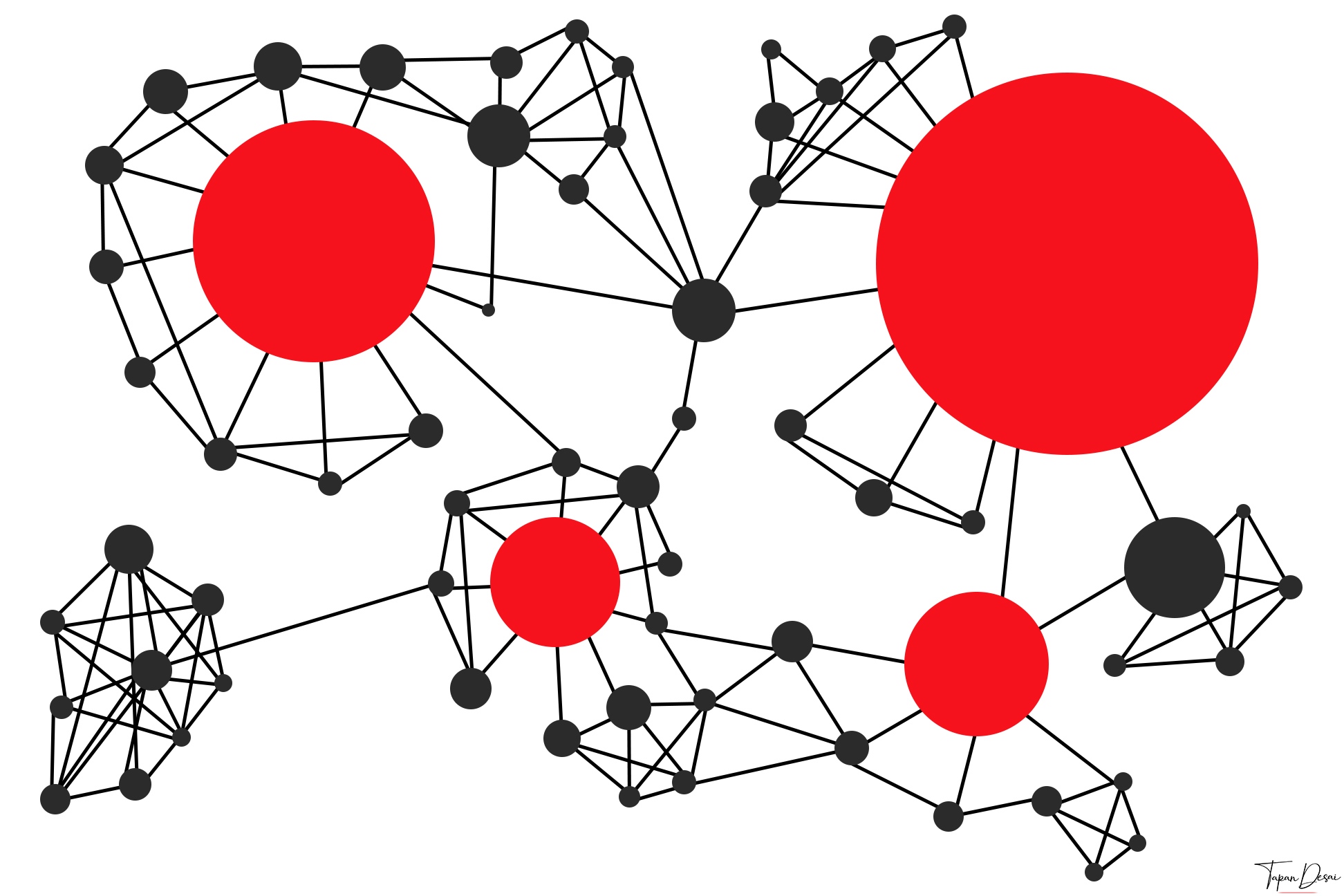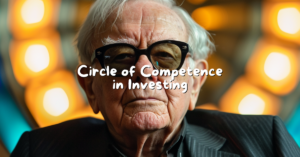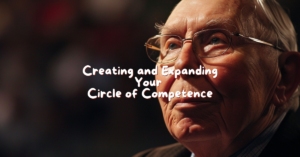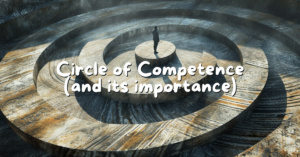What if I told you that since 1994, 70% of the value generated by tech companies is based on one simple concept? Network Effects.
I was introduced to Network Effects as an idea, like so many other things, by Naval Ravikant in his podcast. He said on his podcast, “avoid the news, understand important concepts such as Microeconomics, Network Effects.”
So I started reading about it and was fascinated by the topic. Companies with the strongest types of Network Effects built into their core business model tend to win, and win big.
Network Effects can be applied to relations as well. The most effective way to change yourself is to change your network. And with the addition of each new node in your own network, you can gain value and so will your network. In Gujarati, we call it “odkhaan”.
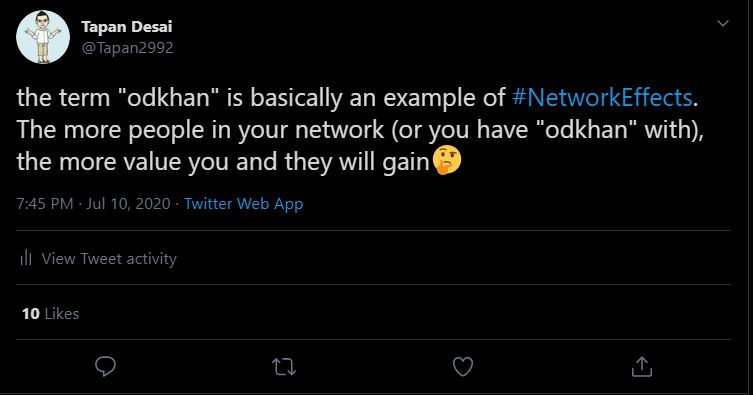
Why should you care about Network Effects? It is an important concept that you can use in your daily life.
Why is Facebook better-valued than Uber? Stronger Network Effects.
Why is Jio increasing it’s value exponentially? Stronger defensibility because of Network Effects.
Why do Instagram accounts grow after you gain a certain number of followers? Integration of Network Effects.
Why are some people connected to more powerful people than others? Yes, Network Effects.
THIS IS PART 1 OF MY NETWORK EFFECTS SERIES. YOU CAN READ THE OTHER PARTS HERE:
- WHAT ARE NETWORK EFFECTS AND WHY ARE THEY IMPORTANT – PART 1
- NETWORK EFFECTS – HOW DO YOU VALUE A NETWORK AND NETWORK EFFECTS- PART 2
- TYPES OF NETWORKS EFFECTS AND VALUING FACEBOOK USING NETWORK EFFECTS – PART 3
- CREATING NETWORK EFFECTS AND IT’S APPLICATIONS IN DAILY LIFE – PART 4
If you understand how Network Effects work, you will see them affecting your life. It’s bloody fantastic. Keep reading to find out how.
Enjoying this post? You can get similar nuggets of knowledge delivered to your inbox, twice-a-month for free. Subscribe to Monthly Mulling💡
WHAT ARE NETWORK EFFECTS?
Let’s start by defining Network Effects? To understand simply, a Network Effect occurs when an additional node (user) has an impact on the network.
If the business has Network Effects, the addition of a new node will increase the value of the network.
The business will become more valuable as more users use it.
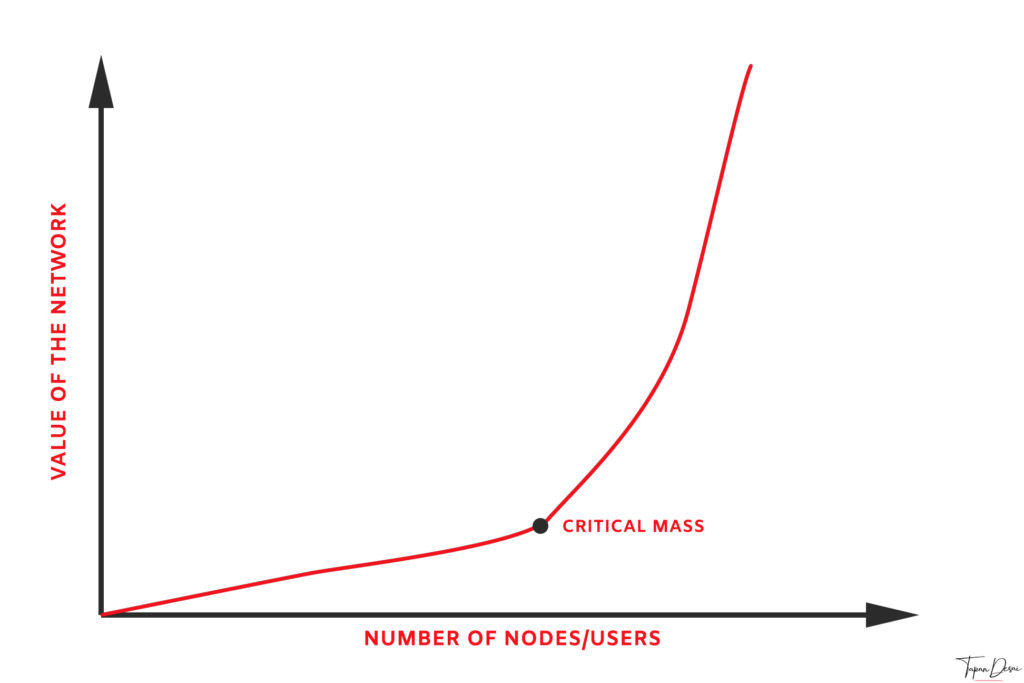
The network effect can create a bandwagon effect as the network becomes more valuable and more people join, resulting in a positive feedback loop. If A creates more of B, B ends up creating more of A.
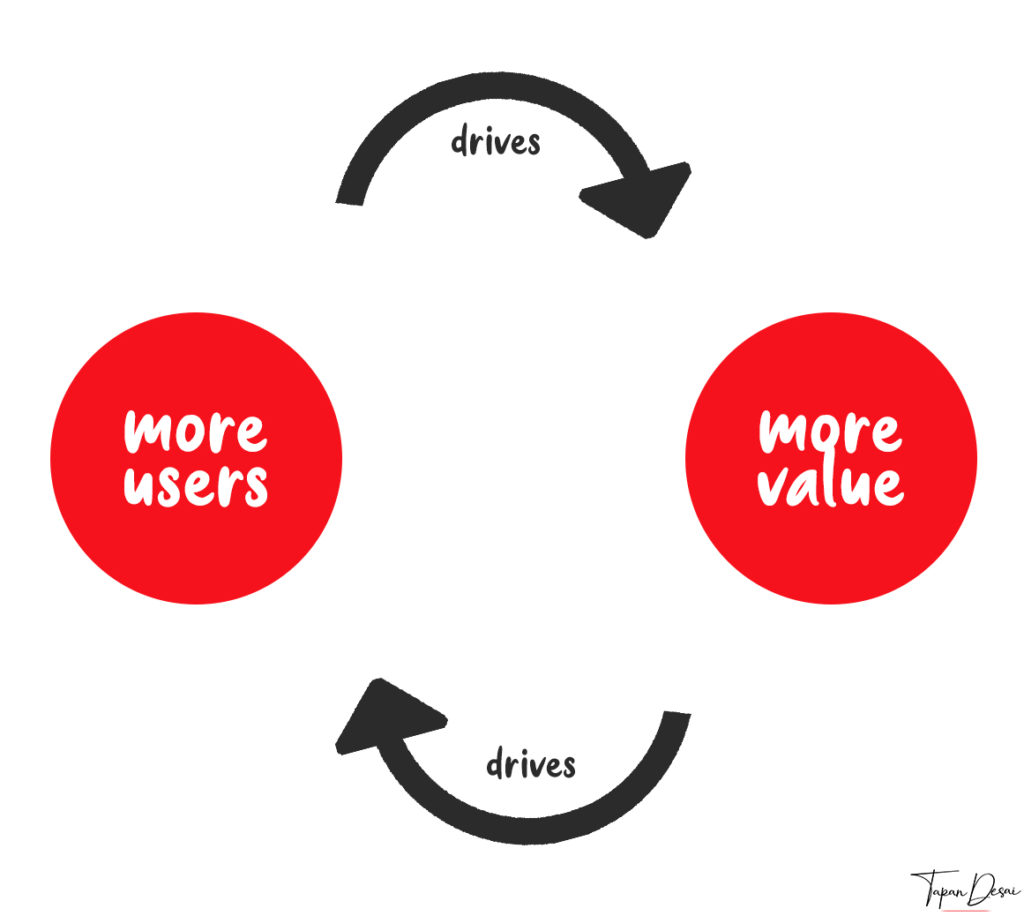
Network Effects can be positive or negative. More users, creating more value is a positive network effect. More users, reducing the value of the network is a negative network effect.
A negative Network Effect ends up reducing the value of the network. Slow internet service because of the number of users on the network is a negative effect.
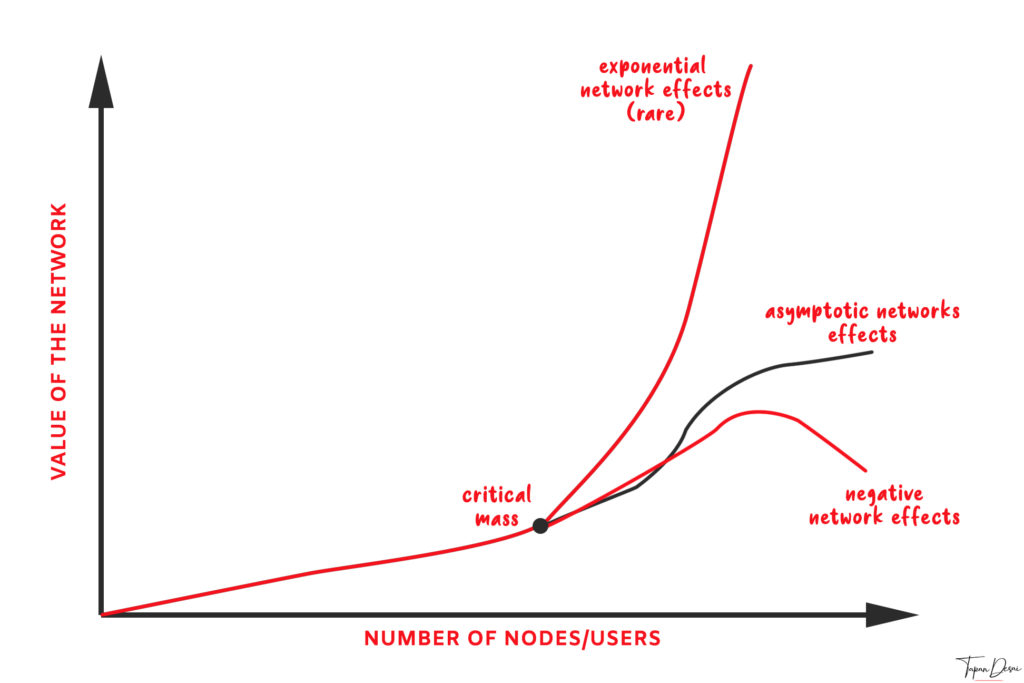
SIMPLIFYING NETWORK EFFECTS THROUGH EARLY-FACEBOOK
An easy way to understand Network Effects will be thinking of Facebook.
When Mark Zuckerberg started Facebook, it was just available for users with a Harvard.edu email address. It was an exclusive network, a small cluster.
Facebook wouldn’t be so interesting initially with 10 users from Harvard but slowly more users from Harvard started signing up. The value of the network increased. Then there were 5000 students, the value of the network grew further; the cluster increased.
And then, what does Mr. Zuckerberg do? He decided to make it available to other colleges; introduced new clusters. The network increased significantly within individual clusters but each cluster could connect to other clusters as well (Harvard students could connect to Stanford students). As more students signed-up, the value of the clusters kept increased and thus, the value of the “network” kept increasing.
Finally, in 2006, Facebook was made public. Anyone with a valid email ID could register. And it blew up! All because of Network Effects.
Facebook had hit its critical mass. If your friends were on it, you had major FOMO. You wanted to join the network and as you joined Facebook, the value of the “network” increased.
Facebook’s Network Effects haven’t flattened in value as more nodes keep adding to it. Yes, there is network pollution (deterioration of network due to unwanted users, read it here) but the value for each user keeps increasing as more users sign-up.
Now, I accept Facebook added a lot more defensibility by embedding its products, creating platforms, scaling operations but the core business model of Facebook is still driven by Network Effects.
THE “NETWORK” IN NETWORK EFFECTS
To understand Network Effects, it is crucial to understand the properties and terms utilized in a network. How do networks work?
A network consists of nodes. Each individual node has different properties. Individual nodes are connected by links. The size of the network can be measured by the number of nodes and links in the network.
PROPERTIES OF A NODE
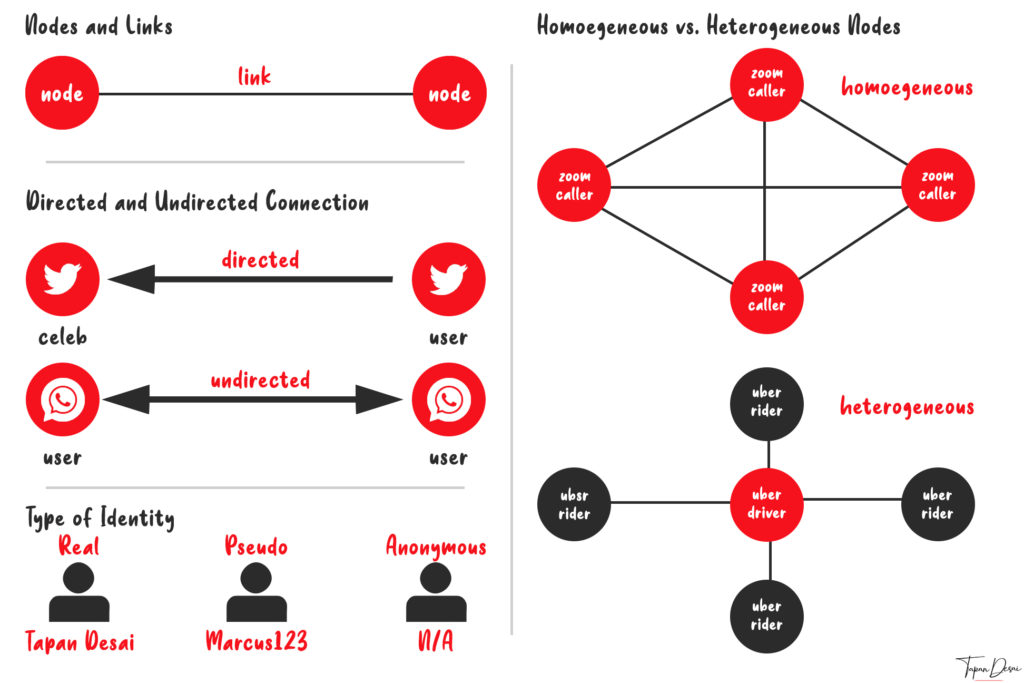
HOMOGENEOUS VS. HETEROGENEOUS NODE
All nodes are the same for in a homogeneous network e.g. if you see Zoom, each user is there to make a call and has the same functions within the application
Nodes are different in heterogeneous networks. One node can take on different roles e.g. an Uber driver has a driver account which is different from a rider account
A network can have homogeneous and heterogeneous nodes simultaneously.
TYPE OF CLUSTER AND DEGREE OF CONNECTION
Can each user connect with each other and their clusters? If they can, to what extent? Imagine Facebook users connecting with each other and then the same users connecting with clusters (or groups) from their schools, colleges, offices; the degree of connection is stronger and thus, the value of the network gets stronger. This article does a great job of explaining the effect here.
It is observed that people are more engaged in a network if they can form a tightly-knit cluster. Instagram launching the “closed group” functionality can be an example of them creating a tightly-knit cluster within an existing network. A tightly-knit cluster creates strong Network Effects
The degree of Connection is an important aspect of a node as well. If users can see their “acquaintances” or “2nd-degree connections”, they are more likely to form a new link with the node. Thus, creating a stronger network.
All the social media platforms do this, Instagram shows “your friends follow them”, LinkedIn shows “degree of connections”, and Facebook shows “acquaintances or recommended friends”.
TYPE OF IDENTITY
There are three types-
- Real identity in a network where people have to use their own identity (true name or company name) to be effectively part of the network. You can see this mostly on Facebook, LinkedIn, Mobile Phone.
- Pseudo Identity where the identity is user-generated but doesn’t have to be related to their true identity. You can see this on users on Reddit and sometimes on Instagram (with business accounts)
- Anonymity where people are completely anonymous such as on YikYak
Networks with real identity have a stronger network effect
TYPE OF CONNECTION
There could be two types of connection in a network, directed or undirected
- In a directed connection, there is a one-way relation between two nodes. In an undirected network (also called a bi-directional connection), you guessed it right, it is a reciprocated connection. The connection works both ways.
Let’s understand it with an example. Twitter users following celebrity accounts is a directed connection. The celebrity doesn’t have to follow a user back. However, if you imagine Whatsapp, the information is mostly undirected i.e. if the two users reciprocate then only can they chat.
COMPLEMENTARY NETWORK
Can you get more value from a product if you use a complementary product (completely different product) that is connected to the network?
A very good example could be understanding Microsoft Office Suite and Windows. Windows users gain more from Office products and vice versa. They are well integrated but different products
NETWORK DENSITY
Network density is the ratio of links to the nodes. The higher the ratio, the greater the network density, the more powerful the Network Effects are.
Imagine Spotify, the network density is low. Not every individual is connected to each other. They might be listening to the same artist but they don’t connect with each other.
Now compare it with a strong network like LinkedIn. Each user is required to connect with the other user plus they can connect to companies. Also, LinkedIn shows posts to 2nd and 3rd-degree connections in the network. Really powerful!
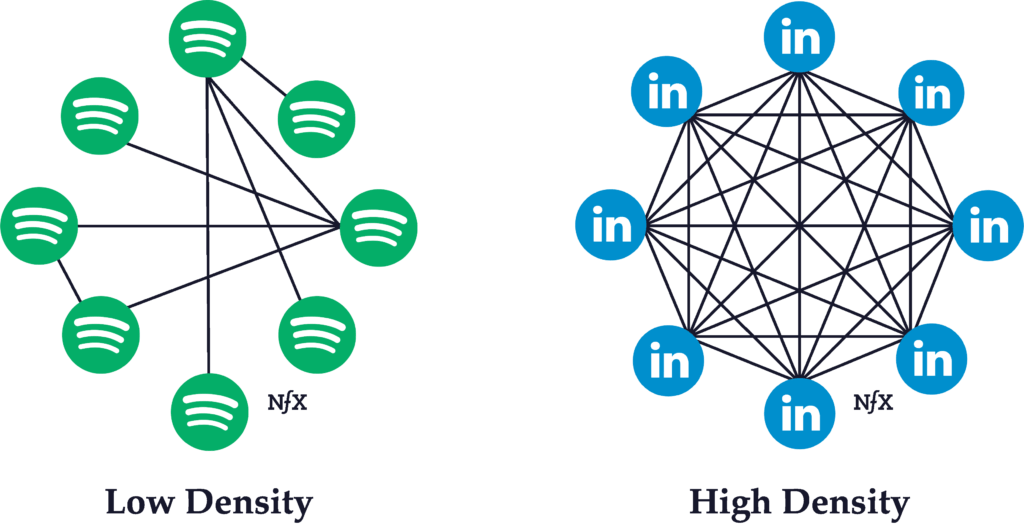
IMPORTANT TERMS IN A NETWORK
NETWORK
A latticework of interconnected users or a system of things (telephones) is called a network.
MARKETPLACE
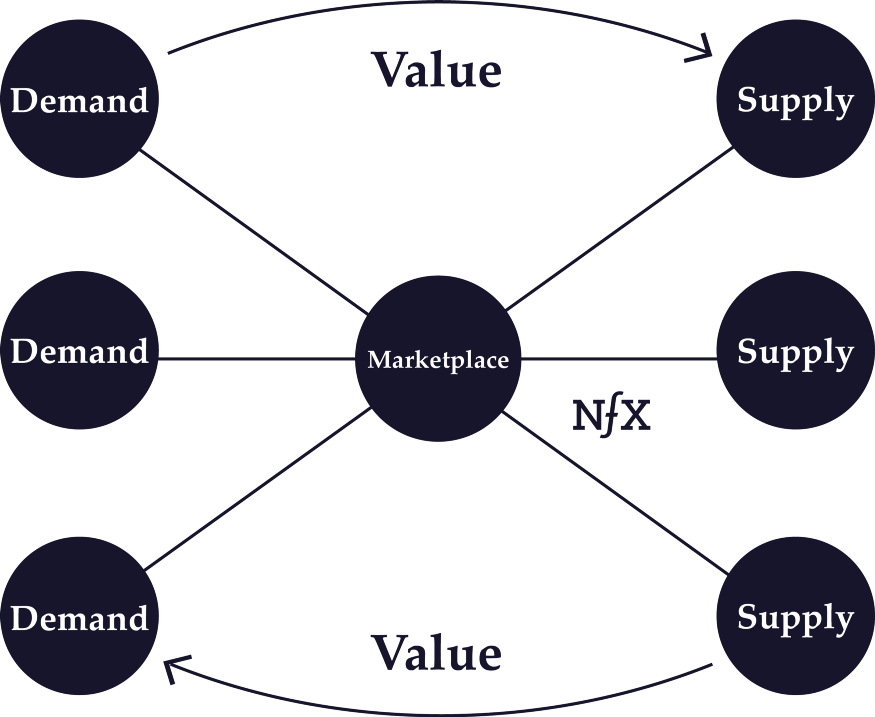
A network where transactions can occur between interconnected heterogeneous nodes. The nodes need to be heterogeneous for the marketplace to work. Imagine an Instagram business account and normal users buying from that account.
Another example would be understanding Airbnb and Network Effects. The more hosts are there on Airbnb, the more rentals are available for the users which drive the growth in the number of new users. And as the number of users increases, more business for the host.
But from the Airbnb example, you can also imagine the issue. Unless, you have a critical mass of hosts, new users won’t join. They wouldn’t have houses to rent. And if there are not enough users, why will new hosts join? The chicken and egg problem.
PLATFORM
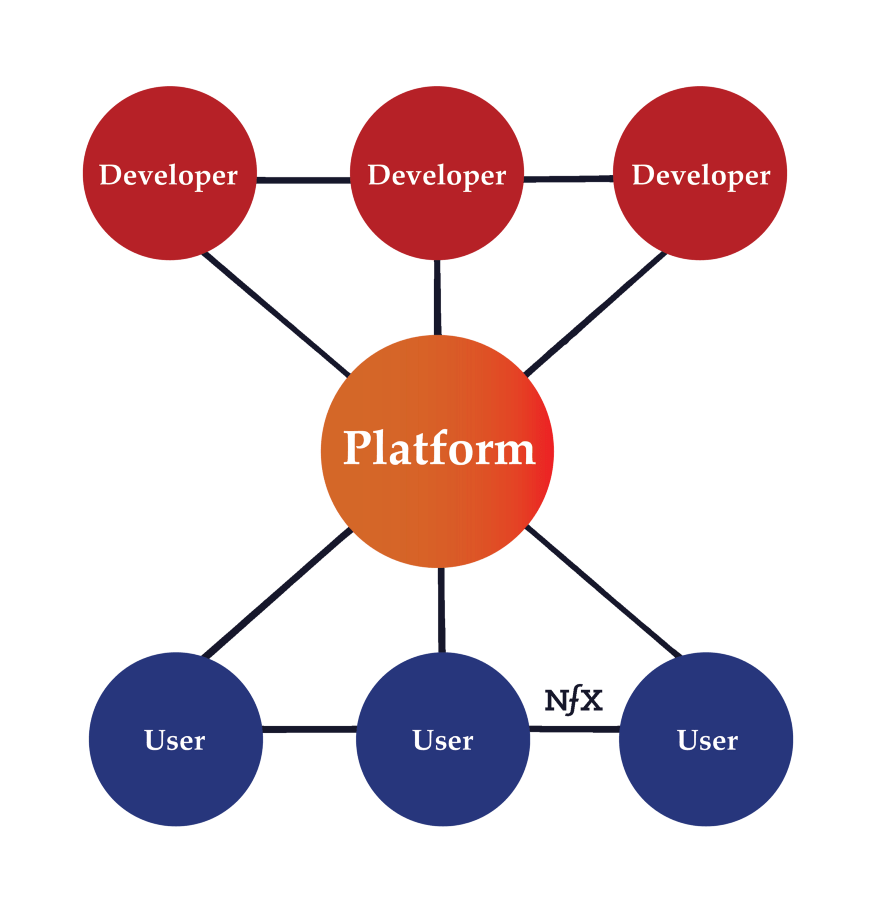
The platform is the most complicated network where users and developers are connected through a feedback loop.
The easiest way to understand is to imagine a network that can be customized, modified by users to increase the value of the network. Imagine Facebook’s platform for developers.
The best way to understand these terms (network, marketplace, and platform) is to understand Facebook, again. Facebook was initially a network with just users. Then it became a platform where developers could use Facebook functionality in their programs which increased value for existing users (you could log in using Facebook ID/Password on multiple platforms). Then they launched a marketplace, where users could run business accounts, thus making it easy for existing users to create interconnected groups.
Facebook is the ultimate case study to understand Network Effects.
WHY ARE NETWORK EFFECTS IMPORTANT?
So we have a basic understanding of Network Effects and components of a network that could cause Network Effects. But why is it important in today’s world?
NETWORK EFFECTS ARE EXPONENTIAL
We live in the times of a global pandemic. You know what makes Coronavirus so powerful? The growth is exponential. One person can infect multiple and it keeps growing from there.
In most cases, Network Effects have an exponential growth as well, after reaching a critical mass, in terms of value derived from the network. I say in most cases because there are networks where you can see the growth stagnate. Read about it here.
More users, more value is derived from the network. The more value, the more users will be added to the network.

It’s a positive feedback loop. And as the network grows, the value of the network grows.
Really powerful stuff.
And now imagine this in terms of cost, if your business/product has Network Effects, the cost of setting up the network will increase linearly (unless you choose to expand a lot in your early days). But since the network will grow exponentially, you will have that much benefit!
Now I understand the above statement is an oversimplification of the benefit but look at this graph by Ray Stern, former CMO of Intuit. He explains the cost vs. value benefit per node.
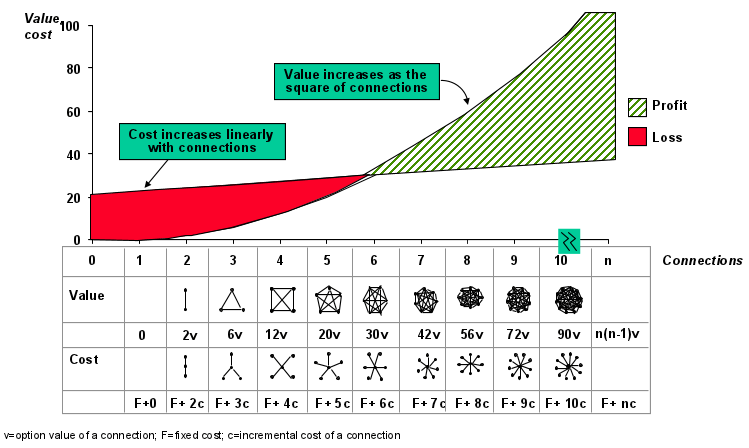
NETWORK EFFECTS IN BUSINESSES – STRONGEST DEFENSIBILITY
In order to understand businesses, you have to understand defensibility. How is your business secure from the competition?
During the age of industrialization, there was multiple defensibility. Several factors such as geolocation, access to raw, government favorability, and so on were important.
But we have modern businesses now. Digital Businesses.
FOUR DEFENSIBILITY IN DIGITAL BUSINESSES
Per the venture firm, NFX, that helps founders get funded there are four defensibility in the modern digital world.
ECONOMIES OF SCALE
When you get big, you will accrue a host of advantages. More users, more volume, cheaper rates. Which is the first company that comes to mind? Amazon, correct.
Amazon has mastered the economy of scale.
This defensibility is difficult to achieve and takes a lot of time. Amazon didn’t become such a large company overnight. They had a large capital and kept diversifying their products.
But now they have scaled so much that it is the first market place people check or join when they want to buy or sell a product.
FFS Amazon’s competitors are selling their products on Amazon!
BRAND
When you develop a loyal fanbase, brand defensibility kicks in. People love and trust these brands and won’t switch to a different brand because they are loyal.
When you think of search engines, Google will be the first company that comes to your mind.
Additionally, with this type of defensibility, people come to recognize themselves with the brand itself.
People buying Nike products, won’t buy Adidas. Checks over strips, right?

EMBEDDED
Embedding works when you embed your business into the customer’s operations, so they can’t use a competing product. These businesses are embedded in the user’s day-to-day operations.
Imagine Trello being used as your project management application. You are so used to using the tool that you won’t change it overnight!
As you would have realized, the initial entry barrier is very high. There is a high probability, your target users would be using an existing service or business which you will have to compete with to replace.
NETWORK EFFECTS
Per NfX, a network effect is when another user makes the service more valuable for every other user. Once your company gets ahead [reaches the critical mass], users won’t find as much value in your competitors’ smaller networks.
Network Effect is the quickest defensibility to obtain for a business and more powerful than the other three defensibility above (Economies of Scale, Brand, Embedded).

Some of the Network Effects are asymptote i.e. the flatten out after reaching a set number of users, while some are exponential i.e. they don’t flatten when more users are added in the network.
EXCHANGE OF INFORMATION
One of the primary sources that make Network Effects important is the exchange of ideas, services, products, and more.
Again going to the basic idea – the value of the network increases as more users are added to the network.
What leads to an increase in value? It’s the exchange of information.
More users are there on the network, more resources and information will be available to the other users. Every product or service subject to network effects fosters some kind of exchange.
Every product or service subject to network effects fosters some kind of exchange. For firms leveraging technology, this might include anything you can represent in the ones and zeros of digital storage, such as movies, music, money, video games, and computer programs. And just about any standard that allows things to plug into one another, interconnect, or otherwise communicate will live or die based on its ability to snare network effects.
Now we have understood what are Network Effects, its properties, and the importance. That’s it for PART 1.
In the next parts, we will cover more of Network Effects –
- WHAT ARE NETWORK EFFECTS AND WHY ARE THEY IMPORTANT – PART 1
- HOW YOU VALUE A NETWORK AND THE LAWS OF NETWORK – PART 2
- TYPES OF NETWORKS EFFECTS AND VALUING FACEBOOK USING NETWORK EFFECTS – PART 3
- CREATING AND APPLICATIONS OF NETWORK EFFECTS IN DAILY LIFE – PART 4
If you liked this article, you will also like –
PRINCIPLES THAT HAVE CHANGED MY LIFE
HOW TO MAKE BETTER DECISIONS – MENTAL MODELS
HOW TO MAKE BETTER DECISIONS – LOGICAL FALLACIES AND BIASES

